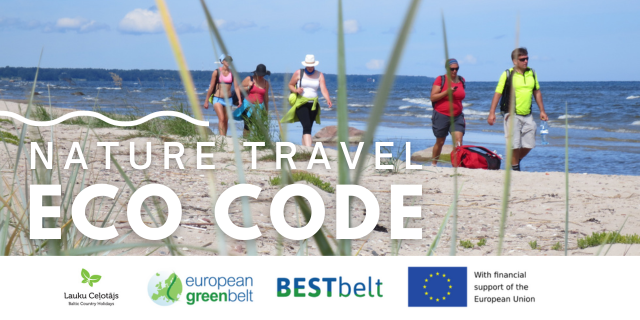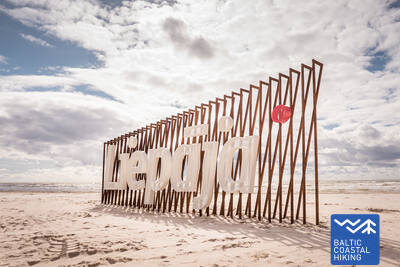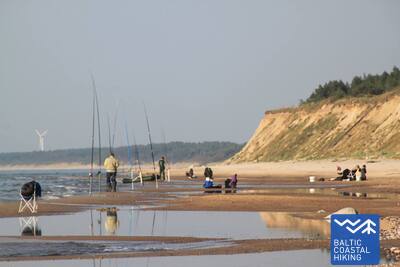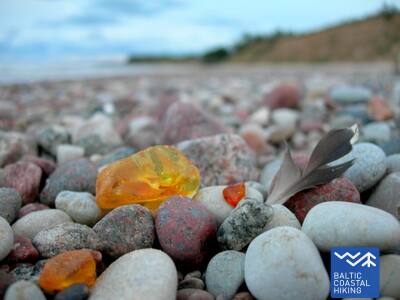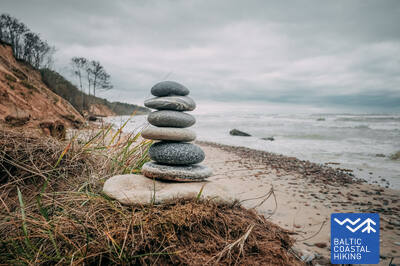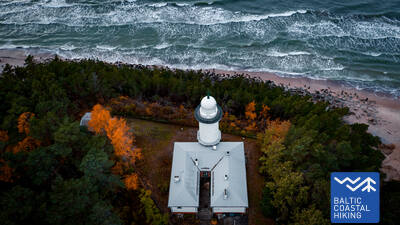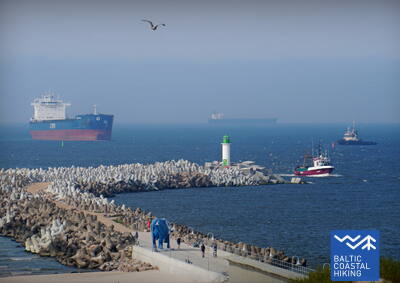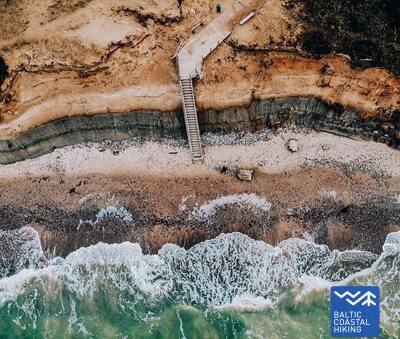Baltic Coastal Hiking trail - Great wave sea
Great wave sea
The West coast of Latvia on the Baltic Sea
Nida – Kolka: 270 km, Day 1-Day 15
The Baltic Sea littoral on the West coast of Kurzeme is called the Great Wave Sea. From the Latvian-Lithuanian border until Cape Kolka, the coast is mostly sandy. While the Great Wave Sea section is the least populated coastal area in Latvia, at the same time, the third biggest city in Latvia, Liepāja, is also located there. Bluffs rise before your eyes on the seacoast between Pāvilosta and Sārnate. The villages are quiet and sparsely populated, with the majority of their inhabitants only living there in the summer. In Slītere National Park, the Baltic Coastal Hiking Route leads you along country and forest roads through historic Livonian fishing villages. In Mazirbe and Kolka, the local fishermen still put out to the sea and sell homemade smokedfish. The Great Wave Sea section ends at Cape Kolka which separates the Baltic Sea and the Gulf of Riga.
 Section 1. Nida - Pape.
Section 1. Nida - Pape.
The Pebbliest Beach In Latvia
The Latvian-Lithuanian border post is the starting point of the Baltic Coastal Hiking Route in Latvia. It goes through the Pape Nature Park crossing a wide beach bathed by the Great Sea along beautiful foredunes overgrown with sand ryegrass and marram grass. This stretch is characterized by a pebbly beach, small peat outcrops and untouched wilderness. By taking a stroll near the Pape Canal you can see a typical landscape of the Piejūra lowlands with Lake Pape hidden in the reeds. The Baltic Coastal Hiking Route winds through Pape village and returns to the beach at the Pape Lighthouse.
 Section 2. Pape - Bernāti.
Section 2. Pape - Bernāti.
The Westernmost point in Latvia
Throughout this section, the Baltic Coastal Hiking Route stretches alongside a beach. In the surroundings of Pape, the coastal side of the beach is surrounded by beautiful foredunes, while further away from the village it transforms into a washed away shore of nearly 10 km with broken pine trees lying across it. Gently sloping dunes reappear near Jūrmalciems. After passing Jūrmalciems, the wide silted beaches continue, but when coming closer to Cape Bernāti, an astounding bluff rises before your eyes which is overgrown with a pine forest and occasionally washed away.
 Section 3. Bernāti - Liepāja - Karosta (The War Port).
Section 3. Bernāti - Liepāja - Karosta (The War Port).
The City Where The Wind Is Born
From Bernāti to Liepāja, the Baltic Coastal Hiking Route leads through a wide beach where initially the coast is formed by washed away shores, but as you approach Liepāja high foredunes covered in sand ryegrass and marram grass appear in sight. Later the trail winds through the old town of Liepāja and “New Liepāja”, crossing the Naval Port Canal to reach the Naval Port: a complex of military and fortification buildings the visitation of which is likely to take a half day. You should certainly try the special dish of Liepāja called Liepājas menciņi made of smoked cod according to an ancient recipe from Southern Kurzeme.
 Section 4. Karosta (The War Port) - Ziemupe.
Section 4. Karosta (The War Port) - Ziemupe.
Karosta - Military Heritage On The Coast Of The Baltic Sea
The first four kilometers of the Baltic Coastal Hiking Route may interest military history enthusiasts with the remains of many forts and coastal defense batteries, but in terms of walking, this is technically the most complicated section of Kurzeme seacoast. After crossing the Fortress Canal, the Baltic Coastal Hiking Route winds through a coastal meadow for a short while, then darts onto a beach and continues as far as Ziemupe. The beach is wide, in times of stronger winds it gets narrower between the Lenkupe and Kārļupīte Rivers. In some places, there are small bluffs, the rest of the section is composed of high, occasionally washed away foredunes. It is said that a lot of ships have sunk in the depths of the Ziemupe River, one of them even had bronze cannons.
 Section 5. Ziemupe - Pāvilosta.
Section 5. Ziemupe - Pāvilosta.
The Singing Sand and Amber
This beach is rarely visited by people and you can gather pieces of amber and little stones with fossils and hear the singing sand beneath your feet. Near Ziemupe, beautiful bluffs appear, but further on near Akmensrags and Pāvilosta there are beautiful, occasionally washed off foredunes overgrown with sand ryegrass and marram grass. In some places, you can see grey dunes. The Akmeņrags Lighthouse will serve as a good place to rest. Pāvilosta, with its provincial charm and the scent of the harbor and smoked fish will bring you back from wilderness to civilization.
 Section 6. Pāvilosta - Jūrkalne.
Section 6. Pāvilosta - Jūrkalne.
The Most Outstanding Bluffs Around The Baltic Sea
To the northeast of Pāvilosta, there are excellent views of the grey dunes, while only a couple of kilometers further you can see the beginning of one of the most beautiful sections the Baltic Coastal Hiking Route with outstanding bluffs continuing for more than 20 km. The most interesting bluff scenery is located near Strante and Ulmale villages and the estuary of the Rīva River. In many places, orchids bloom on the lower part of coastal landslides in summer. In Jūrkalne and in its surroundings, you can see “two sunsets”: the first one from the beach and the second one from the top of the bluff a couple of moments later.
 Section 7. Jūrkalne - Sārnate.
Section 7. Jūrkalne - Sārnate.
The Place Where People Crossed The Baltic Sea In Boats
The astounding bluffs of the Baltic Sea continue in this section of the Baltic Coastal Hiking Route. Near Ošvalki village, it descends turning into a steeper foredune covered in thick osier wreaths, while opposite to Sārnate village distinct bluffs reappear. Here in this comparatively short walking section you can see several impressive sceneries.
 Section 8. Sārnate - Užava.
Section 8. Sārnate - Užava.
The Most Beautiful Scenery Of The Latvian Seacoast
Near Sārnate, you can still see the bluffs of the Baltic Sea, which slowly become lower towards the North and is replaced by a washed away dam of foredunes. Between Vendzavas village and the Užava Lighthouse, you can see coastal sceneries that are quite unusual for Latvia and that remind one of sandy and rocky deserts with sparse vegetation: it used to be a firing ground for the Soviet army. In this place and in the territories of former firing grounds located beyond the Užava Lighthouse, there are now grey foredunes. Getting closer to the estuary of the Užava River, the beach becomes wider and the dunes – lower. The most beautiful scenery of the Baltic Coastal Hiking Route can be seen from the top of the romantic Užava Lighthouse.
 Section 9. Užava - Ventspils.
Section 9. Užava - Ventspils.
Gather Your Amber Collection!
In this section of the Baltic Coastal Hiking Route, the first 6 km are a lonely stretch of the coast with a wide beach and low foredunes, the tops of which are covered in silvery sand ryegrass and marram grass tillers. After passing the Medole brook, an impressive bluff (~ 19 m high) rises before your eyes with a narrow rocky beach beneath it. The bluff quickly shrinks and then rises again two kilometers further. Between the bluffs, there is a former firing ground for the Soviet army. The last five kilometers of the Baltic Coastal Hiking Route to the South Pier in Ventspils lead through a wide sandy beach, the coastal side of which is delimited by the biotopes of grey dunes.
 Section 10. Ventspils - Staldzene.
Section 10. Ventspils - Staldzene.
Through Ventspils
The itinerary goes through Ventspils and its surrounding forests. The Baltic Coastal Hiking Route winds from the South Pier through the historic Ostgals and the Old Town, crosses the Venta River and continues through the Pārventa District via a pedestrian and cyclist path in the direction of Staldzene where it circles the Ventspils Port and then returns to the seacoast. It is worth taking one “day off” and get to know the most interesting places in the city, as well as visit the Seaside Open-Air Museum.
 Section 11. Staldzene - Oviši.
Section 11. Staldzene - Oviši.
Destination – Cape Oviši
When climbing down to the beach of Staldzene, you can already see a bluff that is a couple of meters high and occasionally barren and that gradually becomes higher and higher (the peak point is Kokkalns, at 29 m). 3-4 km to the SE of Staldzene, a narrow section of beach with a bluff has formed, bathed by the waves during strong winds. After passing Liepene, the washed away coastline is slowly becoming lower and beyond Jaunupe, all the way to Cape Oviši, wide beaches have formed with the widest area situated at the tip of Cape Oviši.
 Section 12. Oviši village - Miķeļtornis village.
Section 12. Oviši village - Miķeļtornis village.
Between Oviši Lighthouse and Miķeļbāka Lighthouse
The Baltic Coastal Hiking Route leads through the Oviši Nature reserve where the typical coastal scenery is formed by wide sandy beaches and dunes. Here, the materials naturally found on the beach, the pebbles and sand, create big natural mosaics. In Lūžņa village, military objects from different periods are of interest to visitors, yet near the estuary of the Lūžupe River the seasonal closure must be observed in order to protect the nesting birds: it is prohibited to go there from 01.04. to 01.08. You must go around this place by following the indications marked in the Baltic Coastal Hiking Route. The destination of the itinerary, the Miķeļbāka Lighthouse, can be seen from afar.
 Section 13. Miķeļtornis village – Sīkrags village.
Section 13. Miķeļtornis village – Sīkrags village.
Destination – Slītere National Park
Starting from Miķeļtornis up to the turn towards the cable bridge over the Irbe River, a wide beach with low, sparse foredunes lays before your eyes. For ~ 4,5 km, the itinerary goes around the estuary of the Irbe River where a seasonal closure is in force in order to protect nesting birds and where it is forbidden to enter from 01.04. to 1.08. By taking a detour, the Baltic Coastal Hiking Route passes through a beautiful pine forest with high dunes the slopes of which are rich with mushrooms and berries. After passing the estuary of the Irbe River and as far as Sīkrags village, you will find a stretch of wide sandy beach and ~ 1 km before reaching Sīkrags you will see the Ķikans brook crossing the beach and marking the border of the Slītere National Park. Also in the territory of Ķikana estuary from 1.04. until 1.08. ~ 600 m long beach and dune section is closed to visitors. During this period, people can cross it along the very shore of the sea without undue delay and keep the dog on a short leash.
 Section 14. Sīkrags - Saunags.
Section 14. Sīkrags - Saunags.
The Livonian Coast
A wide sandy beach stretches from Sīkrags village up to Mazirbe beach which is crossed by the Mazirbe Stream. The Baltic Coastal Hiking Route leads out to the center of Mazirbe village where you can see the Livonian National House. Continuing through small forest and country roads past the former Mazirbe Naval school, it winds through small coastal Livonian villages: Košrags, Pitrags and then Saunags. The Livonian Coastline is the only place where you can learn about the cultural heritage of the other indigenous nation of Latvia. In this section, the indicating signs are in both the Latvian and Livonian language.
 Section 15. Saunags village – Kolka.
Section 15. Saunags village – Kolka.
The Heart Of Europe: Cape Kolka
The Baltic Coastal Hiking Route winds through small country and forest roads from Saunags village to Vaide village where it returns to the seacoast again. Wide sandy beaches stretch up to Cape Kolka turning into low sparse foredunes; wooded seaside dunes continue behind them. For around 2 km, there are washed away dunes followed by the Dumbrkalni Hills. Cape Kolka, the point where the Great Sea meets the Little Sea, is one of the most popular bird-watching sites on the Baltic seacoast.










